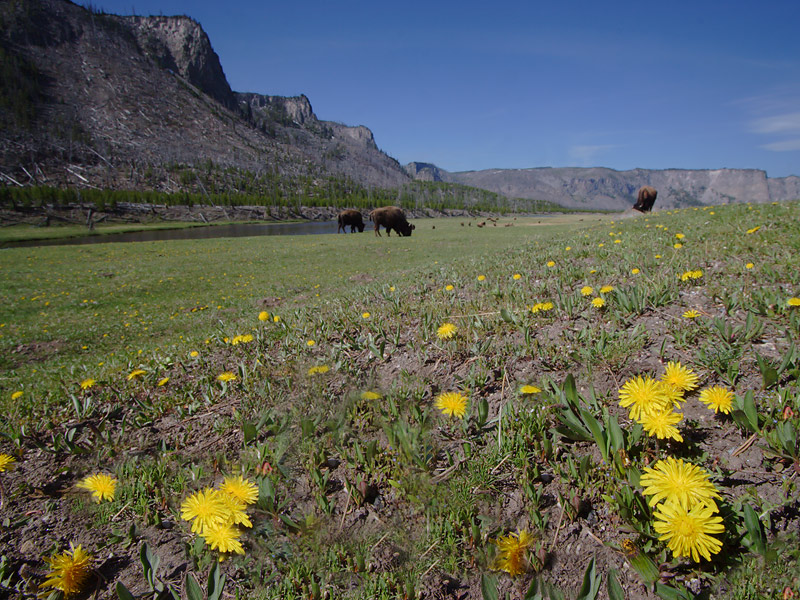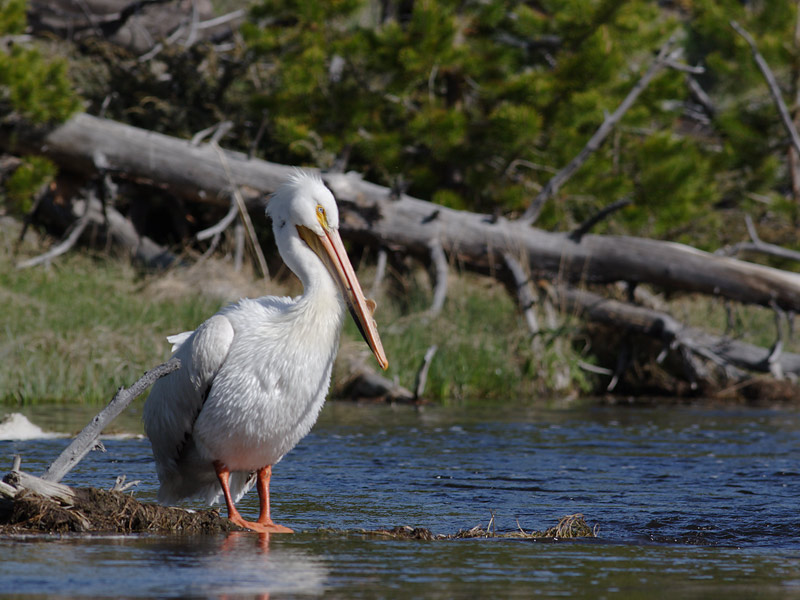|
|

This is the point in the trip where I ask myself "Where did the week go?"
I am glad to leave all the busyness of the hotel behind. West Yellowstone
is usually cooler than Gardiner, but this morning it feels about 60 degrees at 8:30 a.m.
Visitors rush past the Madison River area with its resident bison and elk herds,
speeding toward other parts of the Park. A group of people armed with spotting
scopes and binoculars bend their necks to see the eagles' nest and eagle perched on an adjacent branch.
The nest, at least six years old, is a mangled glob of twigs.

We turn south at Madison Junction to look for goslings in the Firehole River
and discover instead on the Firehole Canyon Drive a waterfall pouring white,
foaming water into the rushing river. The road to Old Faithful is lined with
lush green meadows and stretches of burned trees and deadfall. More bison and
calves wander everywhere. There are lots of geese, but no goslings. At the Nez
Perce Creek we turn around and visit the turnoffs on the Madison again. A couple
of bison are collared, but we're not sure why.
We have time, so we head toward Hayden Valley one last time. There are no wolf jams
this morning and there is nothing left of the carcass the Hayden Pack was feeding on.
Down the road, three otters are swimming upstream in the Yellowstone, their heads bobbing
up and down, their sleek bodies diving like dolphins. They are fast little creatures.
We walk along the shore trying to keep up, but they stay well ahead of us.
This is only the third time we've seen otters in Yellowstone; the other two
in the northern part of the Park at Trout Lake and in the Lamar River towards Cache Creek.
 On the way to Mammoth, vehicles are pulled over to watch two bears high on a slope
north of Twin Lakes. We assume it's the same sow and cub we saw Thursday afternoon.
The bears are high up near the ridge on a slope covered with deadfall and difficult to see.
On the way to Mammoth, vehicles are pulled over to watch two bears high on a slope
north of Twin Lakes. We assume it's the same sow and cub we saw Thursday afternoon.
The bears are high up near the ridge on a slope covered with deadfall and difficult to see.
We are determined to find goslings and search along the Gardiner River, but again, plenty
of geese feeding in the grass, but no little ones. The river is running very fast,
the shore rocky without much grass. It doesn't appear to be an ideal place for a nest,
yet we have seen goslings here before.
The day gets warmer. We find a secluded turnout in the shade of pine trees and throw
together our belongings. This is the first time in several years we are able to pack
our warm jackets because we won't need them for the trip to the airport. This is also
the painful part of the trip - leaving. We hate leaving. But, we can't complain -
we did see six different wolf packs and wolf pups and that alone is a rarity, something most people never see.
Author - Christine Baleshta
Photography - Tim Springer
 |
Click for larger image
|
|

